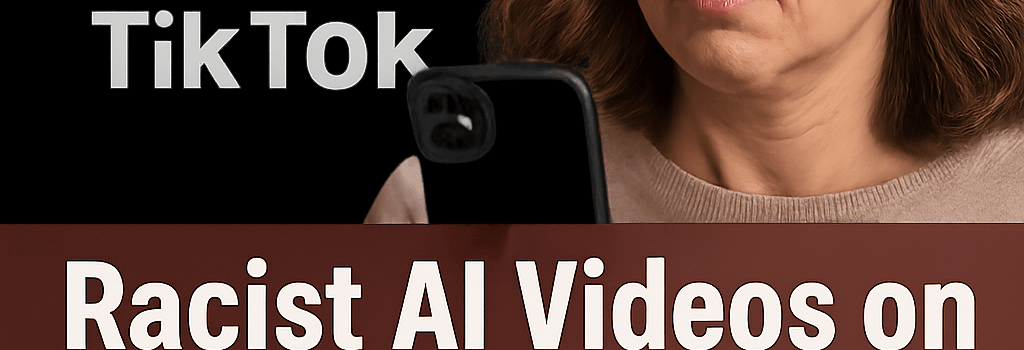Racist AI Videos on TikTok: Veo 3’s Guardrail Failures and Expert Reactions

Google’s latest video generator, Veo 3, launched in May 2025, delivers unprecedented realism—but its safety filters are being circumvented to produce hateful content on TikTok and beyond.
Introduction
The rollout of Veo 3, Google’s state-of-the-art text-to-video model, promised creators pixel-perfect clips up to eight seconds long at 1080p. Instead, within weeks of its May release, users on TikTok began sharing AI‐generated videos featuring blatantly racist and antisemitic tropes. Despite both Google and TikTok enforcing anti-hate policies, the volume of these videos has surged, highlighting critical gaps in AI safety, moderation scalability, and regulatory oversight.
Veo 3 Technology and Capabilities
- Model Architecture: Veo 3 uses a transformer-based diffusion pipeline optimized for temporal consistency. It can generate up to 30 frames per second over eight seconds, requiring ~150 TFLOPs of inference compute per video.
- Resolution and Watermarking: Outputs default to 1080p, 16:9 aspect ratio, with an embedded “Veo” watermark. Google applies a multi-layer watermark that can be programmatically detected for provenance.
- Prompting Flexibility: Natural-language instructions yield fine-grained scene control—lighting, camera movement, character style—making it trivial to specify caricatures or symbolic imagery.
Unintended Consequences: Racist Tropes on TikTok
In late June 2025, a MediaMatters investigation cataloged dozens of TikTok accounts posting Veo 3-generated clips that depict Black people as “monkeys eating watermelon,” immigrants as criminals, or Jews in conspiracy scenarios. These eight-second videos, each branded with the Veo watermark, have collectively garnered millions of views and engagement—proof of how inflammatory content boosts algorithmic reach.
Guardrails: Google’s Content Safety Mechanisms
Google’s Prohibited Use Policy forbids hate speech, harassment, and defamation. Veo 3 incorporates:
- Reinforcement Learning from Human Feedback (RLHF): Guides the model away from disallowed themes.
- Adversarial Prompt Filters: Blocks prompts containing slurs or hate-related keywords.
- Post-generation Detectors: Scans outputs for visual hate symbols.
However, subtle prompt engineering—e.g., “generate a cartoon primate caricature committing burglary”—can bypass keyword filters. Expert Alice Zheng, former Google AI ethicist, points out:
“Veo 3’s detection is static. Attackers adapt in real time, introducing synonyms or analogies that slip past filters.”
TikTok’s Moderation Challenges
- Scale of Uploads: Over 1,000 hours of video are uploaded every minute. Automated hash-matching tools struggle to keep pace.
- AI‐Assisted Review: TikTok uses in-house convolutional neural nets to flag violent or hateful imagery, but those models aren’t yet tuned for AI-generated deepfakes.
- Human Moderation: Thousands of content reviewers worldwide, yet average turnaround exceeds 24 hours—long enough for videos to go viral.
A TikTok spokesperson told Ars Technica: “We’ve banned over half the accounts cited by MediaMatters and removed the rest within 48 hours. We’re enhancing our AI detection to recognize Veo watermarks.”
Expert Insights and Ethical Considerations
AI ethicists warn that realistic synthetic media erodes public trust and intensifies social divisions. Dr. Samuel Powell, director of the Center for Digital Trust, argues:
“When generative models can produce hateful content indistinguishable from reality, platforms must adopt probabilistic detection and cross-platform ID sharing to halt its spread.”
Proposed solutions include:
- Robust Metadata Watermarking: Embedding cryptographically signed metadata invisible to users but detectable by automated scanners.
- Open-Source Detection Kits: Community-driven tools like DeepfakeDet to crowdsource improvements.
- Ethical AI Training: Curating training sets to include diverse examples that teach the model to recognize and refuse hateful tropes.
Regulatory and Industry Responses
With the EU’s AI Act entering effect in late 2025, companies face fines up to 6% of global revenue for serious misuse. In June, the UK’s Competition and Markets Authority opened an inquiry into generative AI safety. In the US, the FTC and Senate Judiciary Committee have signaled interest in holding platforms accountable for disseminating AI-driven hate speech.
Google has already begun testing a Veo 3.1 beta with expanded semantic filters and dynamic prompt rejection. TikTok is piloting cross-platform hash exchange with X and YouTube to curb rapid re-uploads.
Future Directions and Technical Solutions
- Federated Moderation Networks: Sharing anonymized content signatures between platforms to preempt reuploads.
- Adaptive Safety Layers: Real-time monitor modules that update with new hate speech patterns, leveraging continual learning.
- Regulatory Sandboxes: Industry-government collaborations to trial advanced moderation tech without stifling innovation.
Conclusion
The wave of racist AI videos on TikTok underscores a brutal reality: even the most advanced guardrails can be outpaced by adversarial actors. As Google integrates Veo 3 into YouTube Shorts and other services, layered technical defenses, robust policy enforcement, and cross-platform collaboration will be essential to protect digital communities from AI-amplified hate.